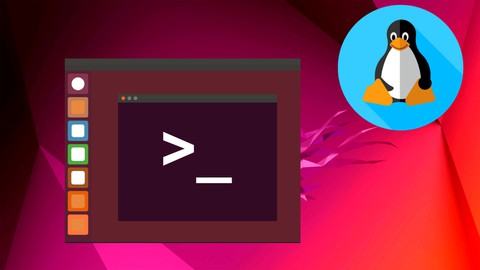
Linux Tutorial – Master The Command Line
Linux Tutorial – Master The Command Line, available at $44.99, has an average rating of 4.33, with 45 lectures, based on 6 reviews, and has 1160 subscribers.
You will learn about How to install Ubuntu Linux on VirtualBox in Windows Basic Linux commands such as "ls", "cd", "mkdir", "rmdir", "touch", "cat", "rm", "cp", and "mv" Advanced topics like file permissions, user and group management, network troubleshooting, network utilities, secure file transfer, and system monitoring Network utilities such as "ifconfig", "ip", "whois", "nslookup", and "wget" Secure file transfer with "ssh" and "scp" System monitoring tools like "uptime", "ps", "top", and "kill" How to use the "nl", "chage", and "passwd" commands This course is ideal for individuals who are Beginners who are new to the Linux command line or Experienced users looking to expand their skills or IT professionals looking to add Linux command line proficiency to their toolkit or Anyone who wants to become proficient in using the Linux command line It is particularly useful for Beginners who are new to the Linux command line or Experienced users looking to expand their skills or IT professionals looking to add Linux command line proficiency to their toolkit or Anyone who wants to become proficient in using the Linux command line.
Enroll now: Linux Tutorial – Master The Command Line
Summary
Title: Linux Tutorial – Master The Command Line
Price: $44.99
Average Rating: 4.33
Number of Lectures: 45
Number of Published Lectures: 45
Number of Curriculum Items: 45
Number of Published Curriculum Objects: 45
Original Price: $199.99
Quality Status: approved
Status: Live
What You Will Learn
- How to install Ubuntu Linux on VirtualBox in Windows
- Basic Linux commands such as "ls", "cd", "mkdir", "rmdir", "touch", "cat", "rm", "cp", and "mv"
- Advanced topics like file permissions, user and group management, network troubleshooting, network utilities, secure file transfer, and system monitoring
- Network utilities such as "ifconfig", "ip", "whois", "nslookup", and "wget"
- Secure file transfer with "ssh" and "scp"
- System monitoring tools like "uptime", "ps", "top", and "kill"
- How to use the "nl", "chage", and "passwd" commands
Who Should Attend
- Beginners who are new to the Linux command line
- Experienced users looking to expand their skills
- IT professionals looking to add Linux command line proficiency to their toolkit
- Anyone who wants to become proficient in using the Linux command line
Target Audiences
- Beginners who are new to the Linux command line
- Experienced users looking to expand their skills
- IT professionals looking to add Linux command line proficiency to their toolkit
- Anyone who wants to become proficient in using the Linux command line
Welcome to “Linux Tutorial – Master The Command Line”!
In this course, you will learn the fundamental skills required to navigate and work with the Linux command line. We will start by installing Ubuntu Linux on VirtualBox in Windows, and then proceed to cover a variety of basic Linux commands, including the “ls” command for listing directory contents, the “cd” command for changing directories, the “mkdir” command for creating directories, the “rmdir” command for deleting directories, the “touch” command for creating files, the “cat” command for displaying file contents, the “rm” command for deleting files, the “cp” command for copying files, and the “mv” command for moving files.
We will also delve into more advanced topics such as file permissions, user and group management with the “chmod”, “useradd”, and “groupadd” commands, the “head” and “tail” commands for viewing the beginning and end of a file, the “chown” and “chgrp” commands for changing file ownership and group membership, and the “ping”, “traceroute”, and “mtr” commands for network troubleshooting.
Additionally, we will cover important network utilities such as “ifconfig”, “ip”, “whois”, “nslookup”, and “wget”, as well as secure file transfer with “ssh” and “scp”. We will also discuss system monitoring tools like “uptime”, “ps”, “top”, and “kill”, and explore the “nl”, “chage”, and “passwd” commands.
By the end of this course, you will have a solid foundation in the Linux command line and be well-prepared to take on more advanced tasks and challenges. So, enroll now and let’s get started!
Course Curriculum
Chapter 1: Introduction
Lecture 1: Introduction
Lecture 2: Ls Command in Linux
Lecture 3: cd Command
Lecture 4: mkdir Command
Lecture 5: rmdir Command
Lecture 6: touch Command
Lecture 7: cat Command
Lecture 8: rm Command
Lecture 9: cp Command
Lecture 10: mv Command
Lecture 11: test
Lecture 12: zip Command
Lecture 13: unzip Command
Lecture 14: Permissions Command
Lecture 15: chmod Command
Lecture 16: useradd – adduser command
Lecture 17: Groupadd command
Lecture 18: Usermod Part 1
Lecture 19: Usermod Part 2
Lecture 20: Head Command
Lecture 21: Tail Command
Lecture 22: Chown Command
Lecture 23: Chgrp Command
Lecture 24: ping Command
Lecture 25: traceroute command
Lecture 26: MTR command
Lecture 27: host command
Lecture 28: ifconfig command
Lecture 29: ip command
Lecture 30: Whois Command
Lecture 31: nslookup
Lecture 32: Wget
Lecture 33: Wget_part2
Lecture 34: SSH Command
Lecture 35: SCP Command
Lecture 36: Uptime Command
Lecture 37: Uname Command
Lecture 38: hostname Command
Lecture 39: passwd Command
Lecture 40: chage Command
Lecture 41: nl Command
Lecture 42: Process
Lecture 43: ps command
Lecture 44: Top Command
Lecture 45: Kill command
Instructors
-
Programming Knowledge
ProgrammingKnowledge
Rating Distribution
- 1 stars: 0 votes
- 2 stars: 0 votes
- 3 stars: 2 votes
- 4 stars: 1 votes
- 5 stars: 3 votes
Frequently Asked Questions
How long do I have access to the course materials?
You can view and review the lecture materials indefinitely, like an on-demand channel.
Can I take my courses with me wherever I go?
Definitely! If you have an internet connection, courses on Udemy are available on any device at any time. If you don’t have an internet connection, some instructors also let their students download course lectures. That’s up to the instructor though, so make sure you get on their good side!
You may also like
- Top 10 Financial Technology Courses to Learn in December 2024
- Top 10 Agile Methodologies Courses to Learn in December 2024
- Top 10 Project Management Courses to Learn in December 2024
- Top 10 Leadership Skills Courses to Learn in December 2024
- Top 10 Public Speaking Courses to Learn in December 2024
- Top 10 Affiliate Marketing Courses to Learn in December 2024
- Top 10 Email Marketing Courses to Learn in December 2024
- Top 10 Social Media Management Courses to Learn in December 2024
- Top 10 SEO Optimization Courses to Learn in December 2024
- Top 10 Content Creation Courses to Learn in December 2024
- Top 10 Game Development Courses to Learn in December 2024
- Top 10 Software Testing Courses to Learn in December 2024
- Top 10 Big Data Courses to Learn in December 2024
- Top 10 Internet Of Things Courses to Learn in December 2024
- Top 10 Quantum Computing Courses to Learn in December 2024
- Top 10 Cloud Computing Courses to Learn in December 2024
- Top 10 3d Modeling Courses to Learn in December 2024
- Top 10 Mobile App Development Courses to Learn in December 2024
- Top 10 Graphic Design Courses to Learn in December 2024
- Top 10 Videography Courses to Learn in December 2024






















